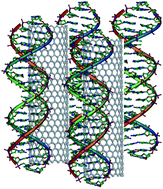Encapsulating carbon nanotubes in aqueous ds-DNA anisotropic phases: shear orientation and rheological properties
Abstract
Carbon nanotubes reinforce polymer composites providing nanotube-based nanohybrids with potentially outstanding properties. The dispersion quality, however, influences the performances of the resulting materials. Therefore, new preparation procedures and efficient dispersion strategies are needed. A new method encapsulating single-walled carbon nanotubes in a nematic phase of double stranded DNA–water–NaCl is reported here. The procedure relies on osmotic compression and on its role in compacting DNA–nanotube composites. An anionic polymer (sodium dextransulfate) was added to the above dispersions and segregative phase separation was induced. DNA–nanotube composites were concentrated and phase-separated from the coexisting polymer solution. In this way, high concentrations of carbon nanotubes can be incorporated in the DNA-rich phase, inducing a transition from liquid- to solid-like behavior. The resulting nematic fluids are homogeneous and orient when shear stresses are applied. The kinetics of re-alignment was determined by rheological and spectroscopic methods. The effect of the nanotubes on the resulting behavior was accounted for. A slowing down of DNA motion observed in such composite matrices suggests interactions with nanotubes.


 Please wait while we load your content...
Please wait while we load your content...